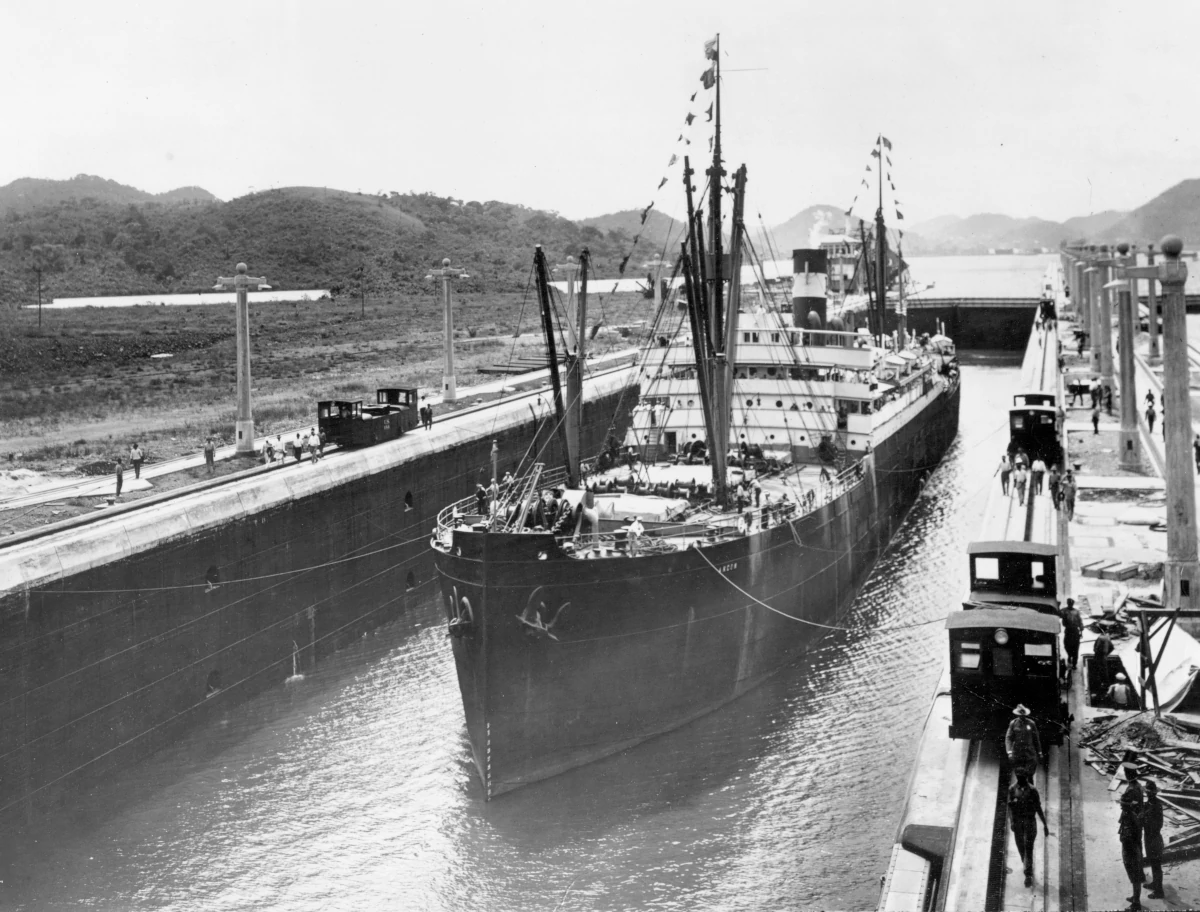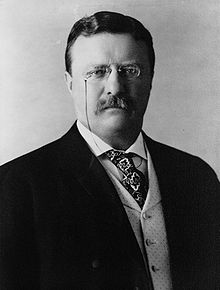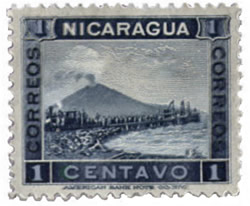Dr. William C. Gorgas
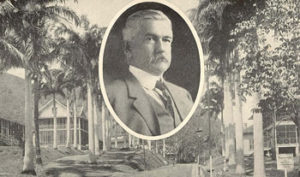
The beginning of the U.S. canal construction effort dates from May 4, 1904, when, in a brief ceremony, U.S. Army Corps of Engineers officer Lieutenant Mark Brooke received the keys to the storehouses and Ancon Hospital. Chief Sanitary Officer Dr .William Crawford Gorgas and his staff were among the first to arrive and set up operations.
Medical researchers at around this time were becoming more receptive to the idea of a relationship between mosquitoes and malaria and yellow fever. Dr. Carlos Juan Finlay, as early as 1881, had become convinced that yellow fever was transmitted by a specific mosquito vector, the Stegomyia fasciata (later to be named the Aedes aegypti). The only problem was that he couldn’t prove what appeared to most at the time to be a totally far-fetched theory. However, others would take their lead from Finlay. Dr. Henry Rose Carter doing research in Mississippi discovered “extrinsic incubation,” the fact that a specific period of time was involved in the person to person transmittal of the disease. However, the great yellow fever discoveries in Cuba in 1900 were the work of Dr. Walter Reed, who happened at the time to be Gorgas’ commanding officer, who proved that Stegomyia fasciata was the carrier, debunking all previous theories, including the belief that “fomites,” the term used for the soiled clothes or bedding of yellow fever victims, could spread the disease. Gorgas, himself a yellow fever survivor and thus immune to the disease, was a particularly valuable member of the medical team. Still skeptical, however, he suggested to Reed that, to prove the theory once and for all, Havana needed to be rid of the Stegomyia fasciata and the results observed. Gorgas, with Reed’s approval, began the work in February of 1901. Results showed a dramatic reduction in yellow fever cases – from 1,400 known cases in 1900, to only 37 cases in 1901; none of them after October. The eradication procedures didn’t just kill off the Stegomyia fasciata, but reduced the Anopheles population as well, thus decreasing malaria cases by more than half. These same techniques were what Gorgas brought with him to Panama in 1904.
The breeding habits of the Stegomyia, which leads them to flourish in and around human habitations, made them much easier to kill than the malaria-carrying Anopheles, which are found everywhere – jungles as well as back yards, making them very difficult to control. Besides, as Gorgas continually stressed, malaria was far more dangerous than yellow fever, accounting for the largest loss of life during the French years.
For Gorgas, it was urgent to get a jump on mosquito eradication before new, non-immune workers arrived and became infected. Unfortunately, Gorgas’s superiors in the first Isthmian Canal Commission didn’t take seriously the new scientific discoveries and thus did not support Gorgas’s efforts. Even after a 1903 scientific congress in Paris reviewed Reeds yellow fever work and proclaimed it “scientifically determined fact,” Commission officials continued to believe Gorgas’s efforts to be a waste of time and money.
John F. Stevens
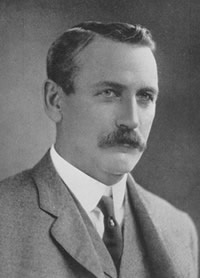
The Isthmian Canal Commission’s first chief Engineer, John F. Wallace, numbered among the nonbelievers. However, John F. Stevens, Wallace’s successor in 1905, provided Gorgas full support and funding. Gorgas would later write, “The moral effect of so high an official taking such a stand at this period…was very great, and it is hard to estimate how much sanitation on the Isthmus owes to this gentleman for its subsequent success.” Stevens’s actions appear even more admirable, as he would later state, “Like probably many others I had gained some little idea of the mosquito theory, but, like most laymen, I had little faith in its effectiveness, or even dreamed of its tremendous importance.”
The work to combat yellow fever included screening windows and doors, house-by-house fumigation of Panama City and Colon and weekly oiling of cisterns and cesspools. A most important advance was providing running water to Panama City, Colon and other townsites to do away with the need for the domestic water containers that served as perfect breeding sites for the yellow fever vector mosquito
As a result of Gorgas’s crusade, yellow fever was completely and permanently wiped out on the Isthmus, with the last case reported in Panama City on November 11, 1905.
Malaria, unlike yellow fever, does not confer immunity. With the disease endemic on the Isthmus, there were repeated opportunities to lay its victims low by debilitation or death. It actually was the cause of more deaths during the French and U.S. construction periods than was yellow fever. During the first year of the American effort, 1905, nearly all of the American force, including Gorgas, had contracted malaria after only a month on the Isthmus. Gorgas was to say, “If we can control malaria, I feel very little anxiety about other diseases. If we do not control malaria our mortality is going to be heavy.” A comparison between eradicating the two kinds of mosquitoes likened getting rid of the yellow fever carrier to “making war on the family cat,” while a campaign against the malaria-carrying mosquito was “like fighting all the beasts of the jungle.”
Reducing and eradicating the swarms of malarial mosquitoes was a huge task. Research, however, revealed valuable information. Knowing that the Anopheles mosquito cannot fly far without lighting on some sort of vegetation, 200-yard-wide areas were cleared around where people lived and worked. Sanitation teams drained more than 100 square miles of swamp, built nearly a thousand miles of earthen ditching, some 300 miles of concrete ditch, 200 miles of rock-filled trench, almost 200 miles of tile drain, cut hundreds of acres of wild vegetation, sprayed standing water with thousands of gallons of oil, hatched and released thousands of minnows to eat the Anopheles larvae and bred spiders, ants, lizards to feed on adult insects. To keep vegetation such as grass and algae from preventing the free spread of the larvae-smothering oil, some 200 barrels of poison (a mixture of carbolic acid, resin and caustic soda) were applied monthly around the edges of water pools and streams. While these efforts covered only a small fraction of the Zone area, they efficiently reduced malaria incidence in populated areas. Two hundred and eleven employees died of malaria during fiscal year 1906-1907, declining significantly from a peak of 7.45 per 1,000 in 1906 to .30 per 1,000 in 1913. This achievement greatly increased American chances of canal-building success. A 1941 report stated that, during the past 20 years, there were only 7 deaths from malaria among employees.
Native villages and towns in the Canal Zone, in accordance with Articles VI and XV of the 1903 treaty, were required to move. Legal owners thus required to vacate were compensated for their property. Many inhabitants were required to relocate with the filling of Gatun Lake. Many of these sites dated from early days of Chagres River navigation, when the route was a much used commercial route across the Isthmus. Such settlements included Ahorca Lagarto, Barbacoas, Caimito, Matachin, Bailamonos, Santa Cruz, Cruz de Juan Gallego and Cruces. Following Canal completion, still other townsites were no longer needed and were abandoned. These towns, some built on the sites of existing French era towns, such as Emperador, called “Empire” by the Americans and the location of steam shovel repair shops and the Central Division engineering office in charge of Culebra Cut excavation. On the other hand, Culebra, the American headquarters, was newly built. Many of these were never intended to be permanent.
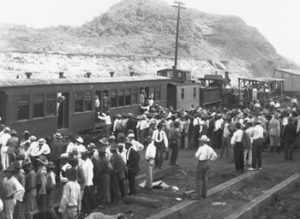
Many problems had to be confronted immediately and solved by John F. Stevens, chief engineer between July 1, 1905 and April 1, 1907. As Panama was, to say the least, insufficiently developed or equipped to support the additional population created by the growing Canal labor force, a great deal of planning went into providing proper housing and an adequate food supply. Virtually everything that was needed for Canal construction, from equipment and building supplies to a labor force and food, would have to be brought to the Isthmus and distributed efficiently along the line of the canal. The Panama Railroad, which Stevens saw at once to be the lifeline of Canal construction, was completely overhauled. The lightweight, inadequate and mismatched equipment of the French was replaced with the best and toughest available, for this railroad would not only distribute workers, materials and supplies, but also would haul away the dirt and rock excavated from the channel. Stevens was to say, “This is no reflection on the French, but I cannot conceive how they did the work they did with the plant they had.” Heavier track, engines, freight cars, dump cars and refrigerator cars were ordered, and bridges signals and sidings were upgraded and improved. Also required and recruited from the United States was a phalanx of trained engineers, switchmen, operators, mechanics, yard masters, train masters, dispatchers, superintendents and conductors to first put together the railroad, as all components were shipped “knocked down,” and then operate it.
All other kinds of equipment were rehabilitated or replaced as well. Communications were improved with new telegraph and telephone systems.
The size of the labor force was tripled in six months under Stevens and whole communities, including housing, mess halls, hospitals, hotels, schools churches, cold storage, clubhouses and laundries were built to accommodate them. Streets were paved in Colon and Panama City and water and sewage systems installed. At one time, nearly half of the 24 thousand-man work force was employed at constructing buildings.
Stevens also developed the ingenious system of Canal excavation and disposal of rock and soil, called “spoil.” He devised a complex but very workable and efficient system of railroad tracks at different levels within the Cut. Spoil train schedules were coordinated to the level where the excavation work was being done. Spoil train capacity kept pace with the excavation work, keeping both trains and steam shovels efficiently employed at all times.
Cnel. George Washington Goethals
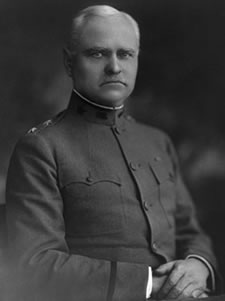
Col. George Washington Goethals, who succeeded Stevens as chief engineer during the construction period and under whose leadership the Canal was completed, would say: “Stevens devised, designed, and made provision for practically every contingency connected with the construction and subsequent operation of the stupendous project… It is therefore to him, much more than to me, that justly belongs the honor of being the actual ‘Genius of the Panama Canal…’”
It was Stevens who convinced Roosevelt of the wisdom and necessity of building a lock rather than a sea level canal, and Stevens who lobbied the U.S. Congress and others on Capital Hill, just as had Frenchman Godin de Lépinay lobbied before the Congres International in Paris in 1879. The difference was that Stevens succeeded. Stevens, with firsthand knowledge of seeing the Chagres during flood, talked, insisted and explained the situation, using statistics and maps, repeating again and again that “the one great problem in the construction of any canal down there is the control of the Chagres River,” during intense questioning before the House Committee on Interstate and Foreign Commerce. He also helped draft the major Senate address by Philander Knox on June 19, 1906, on the subject of the Canal, the lock plan and Gatun Dam in particular. Two days after the Knox speech, the Senate voted for a lock canal 36 to 31; on June 27, the House followed suit. Just a narrow margin of votes stood between United States’ lock canal success and a sea level canal attempt that, in all likelihood, would have failed. Stevens would call the sea level plan “an entirely untenable proposition, an impracticable futility.” Proposed as only 150 feet wide for nearly half its length, it was seen by Stevens as “a narrow, tortuous ditch” fraught with the possibility of endless landslides. Goethals reportedly once remarked that there was not money enough in the world to construct a sea level canal across Panama. Time and construction costs aside, Stevens would still prefer a lock canal:
“It will provide a safer and quicker passage for ships… It will provide, beyond question, the best solution to the vital problem of how safely to care for the floodwater of the Chagres… Its cost of operation, maintenance and fixed charges will be much less than any sea-level canal.”
Stevens estimated completion time for a lock canal to be eight years, by January 1914; he estimated that a sea level canal couldn’t be completed in less than eighteen years, or around 1924.
With all immediate problems solved and the work going well, Stevens suddenly and inexplicably resigned, effective April 1, 1907. Amid much speculation about the reason, Stevens said nothing publicly except to say that it was “personal.” As a professional experienced in railroad engineering, the canal work, for Stevens, was a straightforward administrative and design proposition. He once noted “…the problem is one of magnitude and not miracles.” Roosevelt never had any reservations about Stevens’ technical executive ability, but Stevens’ obvious insensitivity to the fact that the canal was an undertaking of the United States government did not sit well with him.
Now that the canal project was off the ground and going well, Roosevelt’s feeling about it underwent an apparent change. While at first he viewed it as a political, commercial and military necessity, he could now afford to allow himself to be inspired by the “romance” of the situation engendered by its dramatic challenges of its structural design and the many assorted difficulties overcome. Roosevelt now spoke of building the canal as a mighty battle involving both the national honor and that of the work force. The first president to leave the continental United States while in office, he made a trip to Panama in November 1906 to see for himself how things were going. At the end of his last day there, he made an impromptu speech to several hundred Americans, including John Stevens. Excerpts from those remarks reveal his thinking at the time.
“…whoever you are, if you are doing your duty, the balance of the country is placed under obligation to you, just as it is to a soldier in a great war. The man who does his duty, no matter in what position he may be placed, is the man for the job. But to do your duty you must do a little more than just earn your salary. As I have looked at you and seen you work, seen what you have done and are doing, I have felt just exactly as I would feel to see the big men of our country carrying on a great war.”
“…you here who are doing your work well in bringing to completion this great enterprise, are standing exactly as a soldier of the few great wars of the world’s history. This is one of the great works of the world. It is a greater work than you yourselves at the moment realize.”
“In the Grand Army the spirit what appeals to me is the spirit of fellowship, of comradeship. If a man was a lieutenant general of the army or if he was the last recruit, the youngest recruit whose age would permit him to serve in the ranks, it makes no difference. If he did his duty well, he is a comrade, and recognized in every Grand Army post. And so it should be with you, whether you be chief engineer, superintendent, foreman, steam shovel man, machinist, clerk – this spirit of comradeship should prevail.”
Judging from these remarks, it is easy to see how Roosevelt might have felt that Stevens, by his resignation, had betrayed the fundamental precepts of such a great and noble enterprise by viewing it as just a job and not putting into it the commitment of heart and spirit that Roosevelt felt it deserved. While he apparently felt no ill will towards Stevens, he failed to mention Stevens in the canal section of his autobiography. He also determined that he wouldn’t make the same mistake twice, and appointed as Stevens’ replacement an Army man, a member of the U.S. Army Corps of Engineers, who would be required to stay on the job as long as his president and commander in chief wanted him there. The next chief engineer was Lieutenant Colonel (later promoted to Colonel in December 1909 and to Major General on March 4, 1914) George Washington Goethals.
In addition to serving as chief engineer, Goethals also was named chairman of the Isthmian Canal Commission and president of the Panama Railroad Company and its subsidiary steamship line, giving him much more power and responsibility than wielded by previous chief engineers. He was responsible only to the Secretary of War and the President. Such power couldn’t have been entrusted to anyone who could have handled it better than did Goethals, who seemed never to let it go to his head.
Aloof and straight laced in manner and appearance and certainly not an easy mixer or winner of popularity, Goethals was highly respected for his honesty and fairness and was considered a superb administrator by his admirers, of whom there were ample number. He quickly put to rest the fears of those who thought they would be working under a military regime, saying, “I am no longer a commander in the United States Army. I now consider that I am commanding the Army of Panama, and that the enemy we are going to combat is the Culebra Cut and the locks and dams at both ends of the Canal, and any man here on the work who does his duty will never have any cause to complain of militarism.” Goethals never once wore a military uniform on the Isthmus.
Goethals was well qualified for his post, having graduated second in his class at West Point and having had previous experience with locks and dams. Most of his immediate professional subordinates were also military men, including Lieutenant Colonel Harry F. Hodges, Major William L. Sibert, Major David DuBose Gaillard and Rear Admiral Harry Harwood Rousseau. Hodges was in charge of the design and erection of the lock gates. Sibert was head of the Atlantic Division, which comprised Gatun Dam and Locks. Gaillard was in charge of the Central Division, which included all of Gatun Lake and the Culebra Cut. Gaillard died of a brain tumor shortly before the Canal was completed. In posthumous recognition of his service, President Woodrow Wilson issued an executive order on April 17, 1915, officially changing the name of Culebra Cut to Gaillard Cut. Sydney B.Williamson, in charge of the Pacific Division from the southern end of Culebra Cut to deep water in the Pacific, was the only civilian engineer on this high-level team. He was responsible for the construction of Pedro Miguel and Miraflores Locks with their auxiliary dams. The only naval member of the commission, Rousseau was in charge of the design and construction of all terminals, wharves, coaling stations, dry docks, machine shops, warehouses and other auxiliary structures.
Major design changes were made as work progressed. For example, the bottom width of the canal channel in Culebra Cut was widened from 200 to 300 feet. At the request of the U.S. Navy, locks chambers were enlarged from 95 to 110 feet to accommodate vessels then on the drawing board. A chain of small Pacific-side islands (Flamenco, Perico, Naos and Culebra) was joined to create a three-mile-long breakwater across tidal flats to prevent silt from clogging the channel entrance. The discovery of poor foundation materials at the Sosa Hill site caused the two-step set of Pacific-side locks to be relocated farther north to Miraflores; the locations of other locks remained unchanged.
Recruitment of a labor force was a big problem at the beginning of canal construction. With Panama’s relatively sparse population there was no surplus labor anywhere in the republic. It was recognized early on that all classes of labor would have to be recruited from outside and that most of the higher grades of skilled labor would have to be recruited from the United States. The average number of Americans working for the Canal during the construction period was a little over 5,000.
The islands of the Caribbean were the logical place to seek a labor force as the French had done some years before. However, when the French canal effort failed, many West Indian laborers, about 20,000 of them, were left stranded in Panama, to be repatriated at their governments’ expense. This experience left both governments and laborers themselves loath to participate in the American effort. Authorities on the Island of Barbados finally authorized large-scale recruitment leading to a total recruitment of 19,900 laborers, reportedly approximately 10 percent of the population and between 30 and 40 percent of the adult males. When restrictions were withdrawn in 1907, some 7,500 men were recruited from the French islands of Martinique and Guadeloupe. Actually the largest recruitment of contracted workers occurred in 1907, when nearly 15,000 men were brought to the Isthmus. When news got out of the high wages and good living conditions on the Isthmus, there was no longer a need to recruit, and all agents were withdrawn in 1909.
It is often, erroneously, stated that Jamaican labor built the Panama Canal. Actually, Jamaica, the largest, nearest and most populous of the British West Indies, would have been a logical place to recruit unskilled labor. However, throughout the construction period, island authorities consistently refused to allow recruiting, placing a tax of one pound sterling on anyone wishing to leave to work in Panama. For unskilled laborers who made a maximum of about 30 cents a day, to pay the tax and the passage was prohibitive. The large Jamaican immigration to the Isthmus consisted mostly of artisans, not laborers.
Contractors were not used during the American canal construction period except for special projects such as lock gate construction that required especially experienced workers. The McClintic-Marshall Company, which built the lock gates, at one time had more than 5,000 men at work on the gates. Taking this force into consideration, the maximum effective force was reached on March 26, 1913, with a total number of men actually on the job was 44,733, not including the sick, those on leave and other absentees. Taking these into consideration would add an additional 20 percent to the total number on the rolls for any given period.

